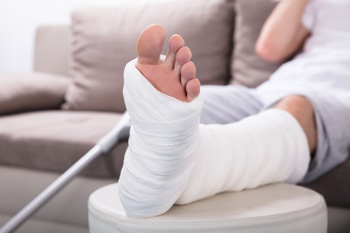What Are Recurrent Stress Fractures?
Monday, 11 January 2021 00:00 Stress fractures are small cracks in a bone and often affect the bones of the feet, ankles, and lower legs. Unlike an acute fracture, which occurs due to a one-time injury, a stress fracture develops slowly and is caused by the affected bone’s inability to bear the load placed on it. Engaging in repetitive activities that place excess pressure on the bones, such as running, can make stress fractures more likely. In a recurrent stress fracture, the affected bone heals, but then breaks again. An estimated 60% of athletes who have had one stress fracture go on to sustain additional stress fractures. If you have fractured any bone, it is important to get treatment and to give the bone adequate time to heal following an injury. For more information about recurrent stress fractures, please consult with a podiatrist.
Stress fractures are small cracks in a bone and often affect the bones of the feet, ankles, and lower legs. Unlike an acute fracture, which occurs due to a one-time injury, a stress fracture develops slowly and is caused by the affected bone’s inability to bear the load placed on it. Engaging in repetitive activities that place excess pressure on the bones, such as running, can make stress fractures more likely. In a recurrent stress fracture, the affected bone heals, but then breaks again. An estimated 60% of athletes who have had one stress fracture go on to sustain additional stress fractures. If you have fractured any bone, it is important to get treatment and to give the bone adequate time to heal following an injury. For more information about recurrent stress fractures, please consult with a podiatrist.
Sports related foot and ankle injuries require proper treatment before players can go back to their regular routines. For more information, contact Dr. Robert Graser of Graser Podiatry and Bunion Surgery Institute. Our doctor can provide the care you need to keep you pain-free and on your feet.
Sports Related Foot and Ankle Injuries
Foot and ankle injuries are a common occurrence when it comes to athletes of any sport. While many athletes dismiss the initial aches and pains, the truth is that ignoring potential foot and ankle injuries can lead to serious problems. As athletes continue to place pressure and strain the area further, a mild injury can turn into something as serious as a rupture and may lead to a permanent disability. There are many factors that contribute to sports related foot and ankle injuries, which include failure to warm up properly, not providing support or wearing bad footwear. Common injuries and conditions athletes face, including:
- Plantar Fasciitis
- Plantar Fasciosis
- Achilles Tendinitis
- Achilles Tendon Rupture
- Ankle Sprains
Sports related injuries are commonly treated using the RICE method. This includes rest, applying ice to the injured area, compression and elevating the ankle. More serious sprains and injuries may require surgery, which could include arthroscopic and reconstructive surgery. Rehabilitation and therapy may also be required in order to get any recovering athlete to become fully functional again. Any unusual aches and pains an athlete sustains must be evaluated by a licensed, reputable medical professional.
If you have any questions please feel free to contact our office located in Boerne, . We offer the newest diagnostic and treatment technologies for all your foot and ankle needs.
Blog Archives
- July 2024
- June 2024
- May 2024
- April 2024
- March 2024
- February 2024
- January 2024
- December 2023
- November 2023
- October 2023
- September 2023
- August 2023
- July 2023
- June 2023
- May 2023
- April 2023
- March 2023
- February 2023
- January 2023
- December 2022
- November 2022
- October 2022
- September 2022
- August 2022
- July 2022
- June 2022
- May 2022
- April 2022
- March 2022
- February 2022
- January 2022
- December 2021
- November 2021
- October 2021
- September 2021
- August 2021
- July 2021
- June 2021
- May 2021
- April 2021
- March 2021
- February 2021
- January 2021
- December 2020
- November 2020
- October 2020
- September 2020
- August 2020
- July 2020
- June 2020
- May 2020
- April 2020
- March 2020
- February 2020
- January 2020
- December 2019
- November 2019
- October 2019
- September 2019
- August 2019
- July 2019
- June 2019
- May 2019
- April 2019
- March 2019
- February 2019
- January 2019
- December 2018
- November 2018
- October 2018
- September 2018
- August 2018
- July 2018
- June 2018
- May 2018








